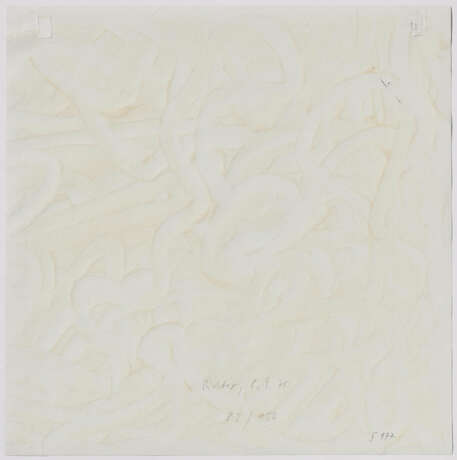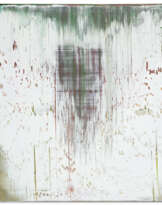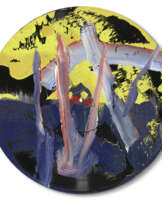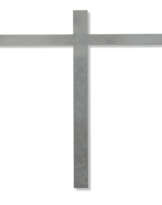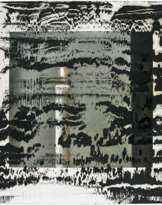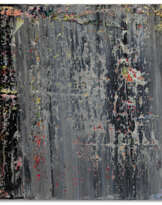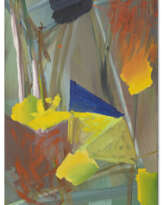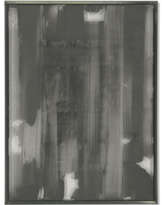ID 1405983
Lot 143 | Gerhard Richter. Vermalung (Grey)
Estimate value
€ 40 000 – 60 000
1932 Dresden
Title: Vermalung (Grey).
Date: 1971.
Technique: Oil on plastic paper.
Measurement: 40 x 40cm.
Notation: Signed, dated and numbered verso lower centre: Richter, 8.9.71 82/150.
Frame/Pedestal: Framed.
The edition is listed on the artist's official website (www.gerhard-richter.com).
Due to the application of the paint with a finger, all sheets differ from each other, making each copy of this edition unique.
According to the catalogue raisonné, 20 of the original 150 copies have been destroyed.
Provenance:
- Bayer Inc, USA (directly from the artist)
- Bayer AG, Leverkusen (acquired from the previous owner in 2005)
Literature:
- Butin, Hubertus/Gronert, Stefan/Olbricht, Thomas (eds.): Gerhard Richter - Editions 1965-2013, Ostfildern 2014, p. 209, cat. rais. no. 45, fig.
- Gerhard Richter has been at the top of the art rankings in the 'Kunstkompass' for 20 years
- The work has a unique character due to its individual treatment
- Characteristic, early example of Richter's intensive preoccupation with the colour grey, which led him to abstraction
Die Farbe Grau in Richters Werk
"Grau ist doch auch eine Farbe, und manchmal ist sie mir die wichtigste." (Vgl. Elger, Dietmar/Obrist, Hans Ulrich (Hrsg).: Gerhard Richter. Text 1961 bis 2007, Köln 2008, S. 61.)
Die Farbe Grau prägt Gerhard Richters Werk seit den 1960er-Jahren. In seinen frühen fotorealistischen Gemälden überträgt er Zeitungs- und Magazinbilder und verfremdet sie durch Unschärfe. Diese Arbeiten ebnen für Richter den Weg zu der von ihm angestrebten Abstraktion. Parallel dazu entstehen die "Farbtafeln", bei denen Grau als monochrome Fläche erstmals in seinen Arbeiten auftaucht. Ab den 1970er-Jahren erhält Grau eine immer größere Bedeutung in seinem Werk und inspiriert ihn insbesondere zu seriellen Arbeiten.
Strukturelle Experimente und der Weg zur "Vermalung"
Ende der 1960er-Jahre beginnt Richter mit verschiedenen Oberflächenstrukturen zu experimentieren. Durch den Einsatz von Rolle und Pinsel entstehen wellenartige und reliefartige Strukturen in seinen Gemälden. Diese Phase führt zu den ersten "Vermalungen", bei denen er die Farbe direkt mit den Fingern aufträgt und verwischt. Durch diese Vorgehensweise erhält jedes Werk eine einzigartige, dynamische Struktur. Ab 1970 entsteht eine Reihe grauer Bilder, darunter das monumentale Diptychon "Fingerspuren (mit Palermo)", in dem Richters Handbewegungen im noch feuchten Farbauftrag sichtbar werden. Zwischen 1971 und 1973 entstehen weitere Arbeiten dieser Art, in denen er sich der Erforschung der Grenzen von Malerei und Abstraktion widmet.
"Vermalung (Grau)", 1971 - ein individuelles Experiment
Das Werk "Vermalung (Grau)" aus dem Jahr 1971 gehört zu einer Serie von 150 Arbeiten, von denen 20 zerstört wurden. Richter trug die graue Ölfarbe mit dem Finger auf und schuf so fein strukturierte, organisch anmutende Farbschichten. Diese Arbeiten sind Unikate, da jedes durch den händischen Farbauftrag einzigartig ist. Der Kunsthistoriker Hubert Butin beschreibt die Fingerabdrücke als "indexikalische Zeichen", die direkt auf den Künstler und seine Hand hinweisen (Vgl. Butin, Hubertus: Gerhard Richter. Unikate in Serie, Köln 2017, S. 98f).
Die "Vermalungen" markieren einen Wendepunkt in Richters Werk, indem sie die traditionelle Bildkomposition auflösen und den prozesshaften Charakter der Malerei betonen. Die Wahl von Grau reflektiert Richters Auseinandersetzung mit Neutralität und Bedeutungslosigkeit - Eigenschaften, die er selbst als faszinierend beschreibt. Die abstrahierte, lebendige Struktur vieler seiner grauen Werke zeigt sich in "Vermalung (Grau)" besonders deutlich. Durch die polymeren Farbschichten erhält die Arbeit eine große räumliche Tiefe. Werke aus dieser Schaffensphase befinden sich in bedeutenden Sammlungen weltweit, darunter das Museum of Modern Art in New York und die Tate Modern in London.
| Artist: | Gerhard Richter (1932) |
|---|---|
| Applied technique: | Oil |
| Auction house category: | Post War paintings, drawings, watercolours |
| Artist: | Gerhard Richter (1932) |
|---|---|
| Applied technique: | Oil |
| Auction house category: | Post War paintings, drawings, watercolours |
| Address of auction |
VAN HAM Kunstauktionen GmbH Hitzelerstr. 2 50968 Köln Germany | ||||||||||||||
|---|---|---|---|---|---|---|---|---|---|---|---|---|---|---|---|
| Preview | |||||||||||||||
| Phone | +49 221 92586215 | ||||||||||||||
| Fax | +49 221 92 58 62 4 | ||||||||||||||
| Buyer Premium | 32% | ||||||||||||||
| Conditions of purchase | Conditions of purchase | ||||||||||||||
| Business hours | Business hours
|
More from Creator
Related terms
- Gerhard Richter (1932)
- Oil
- 1970er
- 1970s
- Abstraktion
- Capitalistic Realism
- Colour
- Deutschland
- Farbe
- Gerhard Richter
- Germany
- Kapitalistischer Realismus
- Nachkriegskunst
- Neuer Realismus
- New Realism
-
Oil
- Papierarbeit
- Post War
- Post-War Art
- Rahmen
- Unikate
- Works on paper
- abstraction
- framed
-
Öl
- Post War paintings, drawings, watercolours


